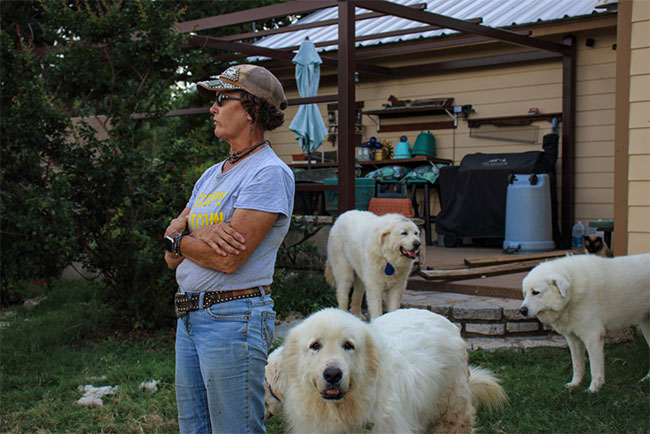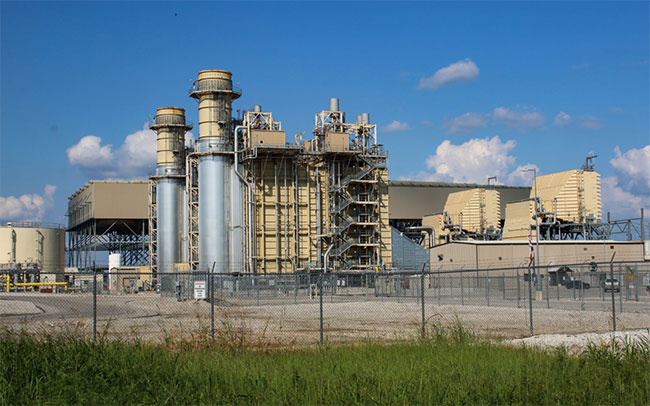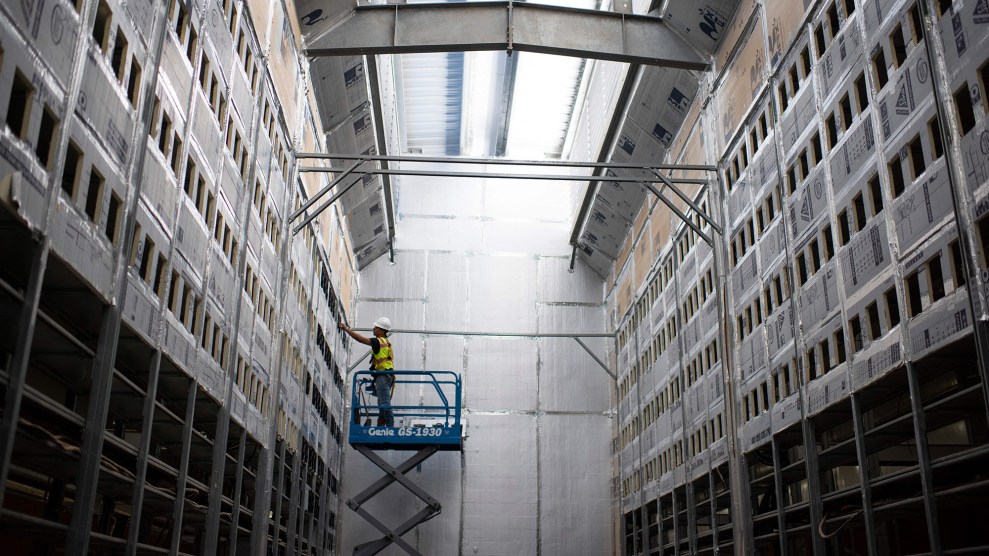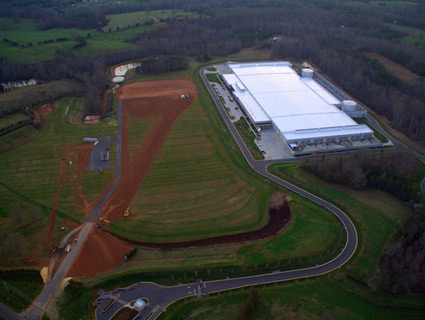
Cheryl Shadden outside her home in Granbury, Texas, with Constellation Energy's Wolf Hollow II power plant in the background.Keaton Peters/Inside Climate News
This story was originally published by Inside Climate News and is reproduced here as part of the Climate Desk collaboration.
Cheryl Shadden cannot sleep. The 61-year-old nurse, who works at hospitals giving patients anesthesia, says she is kept up at night by the nonstop mechanical whir of fans spinning to cool tens of thousands of computers.
Shadden lives in Granbury, Texas, about 40 miles southwest of Fort Worth, with her seven dogs, six horses, six cats and a parrot. In 2022, after 23 years in the area, Shadden got a new neighbor: a 300-megawatt Bitcoin facility, referred to as a “mine,” where computers run around the clock to help maintain a global network of transactions in the cryptocurrency.
“Nobody in their right mind would live here,” Shadden said. “My windows rattle. The sound goes through my walls. My ears ring, 24/7.”
Since the facility opened, Shadden said her animals are restless, and some of her dogs have pulled out their own fur. In late June, Shadden went to a doctor to get her hearing examined, and tests found she had suffered permanent hearing loss. She believes her animals’ behavior and her hearing loss were caused by the noise from the Bitcoin mine.
Noise pollution is not the only reason that Bitcoin mining may be keeping Texans up at night. The mine owned and operated by Marathon Digital is part of a growing tide of cryptocurrency mining facilities opening across the country, but especially in Texas, where taxes are low, land is plentiful and mining companies can take advantage of the state’s deregulated energy market. As electricity demand rises, ordinary Texans can end up paying the price on their monthly utility bills.

Bitcoin is the largest and best known cryptocurrency, first devised in 2008 as an electronic payment system that cuts out middlemen like banks and credit card companies, with all transactions managed by a decentralized network of Bitcoin users. A Bitcoin, currently worth about $58,000, can be purchased with dollars at a Bitcoin exchange, like Coinbase. To buy something with Bitcoin, a buyer sends the currency from a digital wallet to the seller’s digital wallet.
But it’s not that simple. A computer algorithm assigns each transaction a unique random identifying code, which must be guessed in order to validate the transaction. Bitcoin “mining” comes when companies operate powerful computers day and night running endless series of random numbers before hitting upon, or guessing, the correct code. Every time a Bitcoin miner’s computer successfully guesses a transaction code, the miner receives 3.125 newly minted Bitcoins (worth about $181,250 at the current price), which is the fee for helping maintain the network and keep it secure.
Cryptocurrency mining, mostly for Bitcoin, draws up to 2,600 megawatts from the regional power grid—about the same as the city of Austin. Another 2,600 megawatts is already approved.
The system is designed so that it takes an average of 10 minutes for a Bitcoin miner somewhere in the world to guess a code and verify a transaction. But as Bitcoin miners add computing power to verify more transactions, the system’s algorithm makes the process harder by generating longer codes, creating what has been called an energy arms race, requiring larger and larger amounts of electricity to run the computers.
Texas is now home to 10 of 34 large Bitcoin mines.
During cold spells or heat waves, Texans are commonly called on to conserve power. For example, in August 2023, the state’s grid operator issued eight conservation requests, asking the public to reduce electricity use to help prevent an emergency in which rolling blackouts could be required. Increasingly, Texas lawmakers are worried that energy-hungry mines will make it harder to keep the lights on across the state.
“They’re going to put our grid at risk because of the power they’re drawing,” said state Sen. José Menéndez (D-San Antonio) at a public hearing on June 12.
For more than six hours, senators on the Business and Commerce Committee pressed grid operators, public utility commissioners and representatives from industries, including manufacturing, oil and gas and cryptocurrency. Chief among legislators’ concerns was the massive growth in energy demand on the state’s main electrical grid, which is estimated to go from a peak demand of about 85,000 megawatts last year to 150,000 megawatts in 2030, according to estimates from the Electric Reliability Council of Texas.
Following the hearing, in a post on social media, Lt. Gov. Dan Patrick declared, “it can’t be the Wild Wild West of data centers and crypto miners crashing our grid and turning the lights off.”

Currently, cryptocurrency mining—mostly for Bitcoin—can draw up to 2,600 megawatts of power from the grid operated by the Electric Reliability Council of Texas, ERCOT’s senior vice president, Woody Rickerson, told senators. That’s about the same amount of power used by the city of Austin, and another 2,600 megawatts of mining is already approved to connect to the grid. Even more Bitcoin mines are expected to come to Texas in the near future.
ERCOT estimates that as much as 43,600 megawatts of additional electricity demand will be added to the grid by 2027 from facilities classified as “Large Flexible Loads” requiring more than 75 megawatts. In a statement to Inside Climate News, ERCOT said, “currently, the crypto mining industry represents the largest share of large flexible loads seeking to interconnect to the ERCOT System.” Data centers for artificial intelligence and facilities for producing hydrogen from water through electrolysis also make up part of the large flexible loads.
In August 2023, when energy prices were high amid scorching summer days, Riot Platforms made $24.2 million from reselling power purchased wholesale through private agreements.
To meet the major growth in demand, driven in large part by Bitcoin mining, Texas is turning to natural gas power plants, with taxpayers providing the down payment. In 2023, the Texas legislature passed a loan program, later approved by voters as ballot Proposition 7, to give low-interest loans to companies to build or expand power plants. At first, the Texas Energy Fund will have $10 billion to award, after receiving more than $39 billion in requests.
One of the companies applying for a loan is Constellation Energy, which owns the Wolf Hollow II power plant in Granbury. Constellation has an agreement with Marathon Digital, allowing Marathon to rent space next to the power plant for Bitcoin mining and purchase power directly from Wolf Hollow II.
Marathon has a capacity to use up to 300 megawatts of power, and Constellation wants to add additional turbines onto Wolf Hollow II capable of generating that much power.
In an application to the Texas Commission on Environmental Quality, Constellation said the power plant expansion would include eight turbines, and it applied for air permits to release more than 796,000 additional tons of carbon dioxide per year. Such massive greenhouse gas emissions have made cryptocurrency mining the focus of intense opposition by climate activists.
The deal between Marathon and Constellation, known as a power purchase agreement, is part of what makes Bitcoin mines major players in the Texas energy market—not simply consumers of power. In most agreements, crypto facilities lock in a relatively low rate to purchase electricity “behind the meter,” so the supply does not enter the ERCOT market. But Bitcoin mining companies can later decide to sell that power to the rest of the grid through the ERCOT market, rather than powering their computers.
For example, Riot Platforms operates two of the largest existing Bitcoin facilities in the world, both located in Texas. The New York Times reported last year that Riot Platforms’ operation in Rockdale was the most power-intensive Bitcoin mining operation in the country, using “about the same amount of electricity as the nearest 300,000 homes.”
One of the facilities has been able to pay as low as 2.5 cents per kilowatt-hour of electricity, while the average price across Texas in 2022 was more than 10 cents.
In August 2023, when energy prices were high amid scorching summer days, Riot Platforms made $24.2 million from reselling power purchased through their private agreements onto the wholesale energy market, almost tripling the $8.6 million the company made that month mining and selling Bitcoin.
“They can game the system in a few different ways for their profit,” said Mandy DeRoche, an attorney at the nonprofit Earthjustice, who has worked on cases involving crypto mines across the country.
“The cost is passed directly on to ratepayers,” said the Texas director for Public Citizen. Bitcoin miners “are ideally positioned to manipulate the energy market in a way that will drive up prices.”
Separately, Bitcoin companies can participate in demand response programs, in which the companies allow ERCOT operators to control the energy load of the facility and lower their usage to compensate for sudden outages or periods of high demand elsewhere on the grid. These situations arise most often during extreme weather. Companies get paid a premium by ERCOT for participating in demand response, and they get paid an additional fee each time their energy load is controlled through the program. Riot Platforms made $7.2 million from these programs in August 2023, according to a monthly earnings report.
“Texas has set up a system which allows crypto mining to be significantly advantaged,” said state Sen. Charles Schwertner (R-Georgetown), the chairman of the Business and Commerce Committee.
Those millions in profit don’t appear out of thin air, and consumer advocates are worried the burden falls on Texans such as Cheryl Shadden and her neighbors in Granbury. “The cost is passed directly on to ratepayers,” said Adrian Shelley, Texas director for the nonprofit Public Citizen. Bitcoin miners “are ideally positioned to manipulate the energy market in a way that will drive up prices for consumers.”
With three distinct ways to profit—energy-intensive computations to “mine” Bitcoin, selling power on the wholesale energy market or participating in demand response—each decision will impact the availability of energy for most of Texas. And which method miners choose is highly variable.
As DeRoche explains, “if the price of Bitcoin is fairly low, then there’s more incentive to turn off [their computers] in peak demand or in extreme weather.”
This year, the price of Bitcoin has soared to record highs and remained steadily around $60,000 since March, about twice as high as in August 2023. With the price up, DeRoche said it will be harder to predict whether miners will power down when energy becomes scarce.
From the industry perspective, Bitcoin advocates say the flexibility of mining operations makes the grid stronger. “We need more price sensitive loads on the grid, not less,” said Lee Bratcher, president of the Texas Blockchain Council, in an email to Inside Climate News. “By locating in rural areas with too much power and not enough transmission capacity to get that power to major population centers,” Bratcher said the cryptocurrency mining industry is using power that would otherwise go to waste.
He added that many mines operate at full capacity during the night when demand is low and power down “during high power demand times like during hot afternoons in the summer or winter cold snaps.”
Bratcher, as well as representatives from Marathon Digital and Constellation Energy, declined to be interviewed. In an email, Jim Crawford, chief operating officer for Marathon, also said that the company incentivizes wind and solar power generation by signing power purchase agreements with renewable energy generators.















